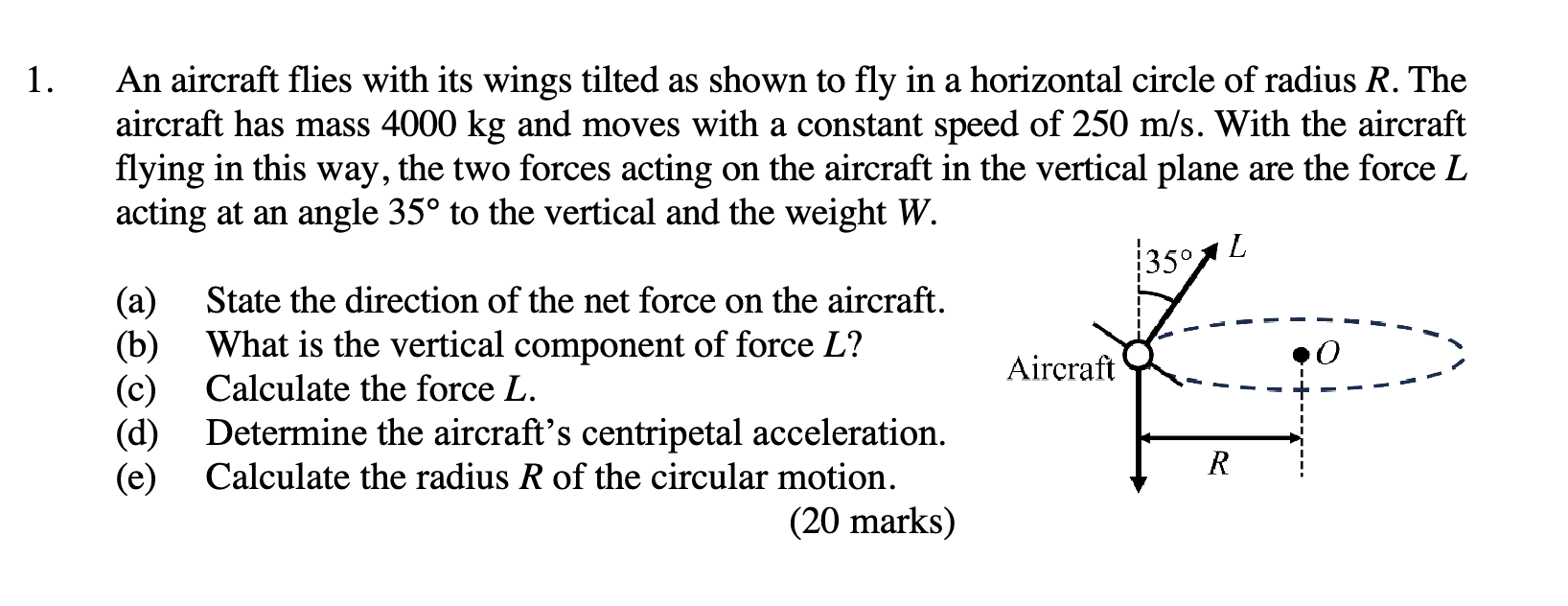An aircraft flies with its wings tilted as shown to fly in a horizontal circle of radius R. The aircraft has mass 4000 kg and moves with a constant speed of 250 m/s. With the aircr... An aircraft flies with its wings tilted as shown to fly in a horizontal circle of radius R. The aircraft has mass 4000 kg and moves with a constant speed of 250 m/s. With the aircraft flying in this way, the two forces acting on the aircraft in the vertical plane are the force L acting at an angle 35° to the vertical and the weight W. (a) State the direction of the net force on the aircraft. (b) What is the vertical component of force L? (c) Calculate the force L. (d) Determine the aircraft's centripetal acceleration. (e) Calculate the radius R of the circular motion.

Understand the Problem
The problem describes an aircraft flying in a horizontal circle with its wings tilted. You are given the aircraft's mass, speed, and the angle of the lift force (L) relative to the vertical. The problem requires you to determine: (a) the direction of the net force, (b) the vertical component of the lift force L, (c) the magnitude of the lift force L, (d) the centripetal acceleration of the aircraft, and (e) the radius R of the circular path.
Answer
(a) Horizontal and towards the center of the circle. (b) $39200 \, \text{N}$ (c) $L \approx 47863.25 \, \text{N}$ (d) $a_c \approx 6.87 \, \text{m/s}^2$ (e) $R \approx 9097.53 \, \text{m}$
Answer for screen readers
(a) The direction of the net force is horizontal and towards the center of the circle. (b) The vertical component of force L is $39200 , \text{N}$. (c) The force L is approximately $47863.25 , \text{N}$. (d) The aircraft's centripetal acceleration is approximately $6.87 , \text{m/s}^2$. (e) The radius R of the circular motion is approximately $9097.53 , \text{m}$.
Steps to Solve
- Direction of the Net Force
Since the aircraft is moving in a horizontal circle, the net force must be directed towards the center of the circle. This net force is the centripetal force, which causes the circular motion. Therefore, the direction of the net force is horizontal and towards the center of the circle.
- Vertical Component of Force L
The vertical component of the lift force $L$ must balance the weight $W$ of the aircraft since there is no vertical acceleration. The weight $W$ is given by $W = mg$, where $m$ is the mass and $g$ is the acceleration due to gravity ($g \approx 9.8 , \text{m/s}^2$). The vertical component of $L$ is $L\cos(35^\circ)$. Thus, $L\cos(35^\circ) = W$.
- Calculate Weight W
Let's calculate the weight of the aircraft $W = mg = 4000 , \text{kg} \times 9.8 , \text{m/s}^2 = 39200 , \text{N}$
- Vertical component of Lift Force L
Since $L\cos(35^\circ) = W$, the vertical component of the Lift force is equal to $W$ that we have found in the previous step: Vertical component of $L$ = $39200 , \text{N}$.
- Calculate Force L
Using the equation $L\cos(35^\circ) = W$, we can solve for $L$: $L = \frac{W}{\cos(35^\circ)} = \frac{39200 , \text{N}}{\cos(35^\circ)}$
Calculating $L$: $L = \frac{39200}{0.819} \approx 47863.25 , \text{N}$
- Aircraft's Centripetal Acceleration
The horizontal component of the lift force $L$ provides the centripetal force $F_c$. The horizontal component is $L\sin(35^\circ)$. $F_c = L\sin(35^\circ) = ma_c$, where $a_c$ is the centripetal acceleration.
We calculate $L\sin(35^\circ)$: $L\sin(35^\circ) = 47863.25 , \text{N} \times \sin(35^\circ) = 47863.25 , \text{N} \times 0.574 \approx 27466.9 , \text{N}$
Now we can calculate the centripetal acceleration $a_c = \frac{F_c}{m}$: $a_c = \frac{27466.9 , \text{N}}{4000 , \text{kg}} \approx 6.87 , \text{m/s}^2$
- Calculate the Radius R
We know that centripetal acceleration is also given by $a_c = \frac{v^2}{R}$, where $v$ is the speed and $R$ is the radius. We can solve for $R$: $R = \frac{v^2}{a_c} = \frac{(250 , \text{m/s})^2}{6.87 , \text{m/s}^2}$
Calculate $R$: $R = \frac{62500}{6.87} \approx 9097.53 , \text{m}$
(a) The direction of the net force is horizontal and towards the center of the circle. (b) The vertical component of force L is $39200 , \text{N}$. (c) The force L is approximately $47863.25 , \text{N}$. (d) The aircraft's centripetal acceleration is approximately $6.87 , \text{m/s}^2$. (e) The radius R of the circular motion is approximately $9097.53 , \text{m}$.
More Information
Centripetal force is always directed towards the center of the circle, causing the object to change direction constantly without changing speed.
Tips
A common mistake is to confuse the angle given with respect to the vertical with the angle with respect to the horizontal, leading to incorrect trigonometric functions. Also, forgetting to balance the forces in the vertical direction is a frequent error. Incorrectly applying the centripetal acceleration formula or mixing up units is also possible. Finally, not considering the impact of the tilted lift force on both vertical and horizontal force components can result in calculation mistakes.
AI-generated content may contain errors. Please verify critical information